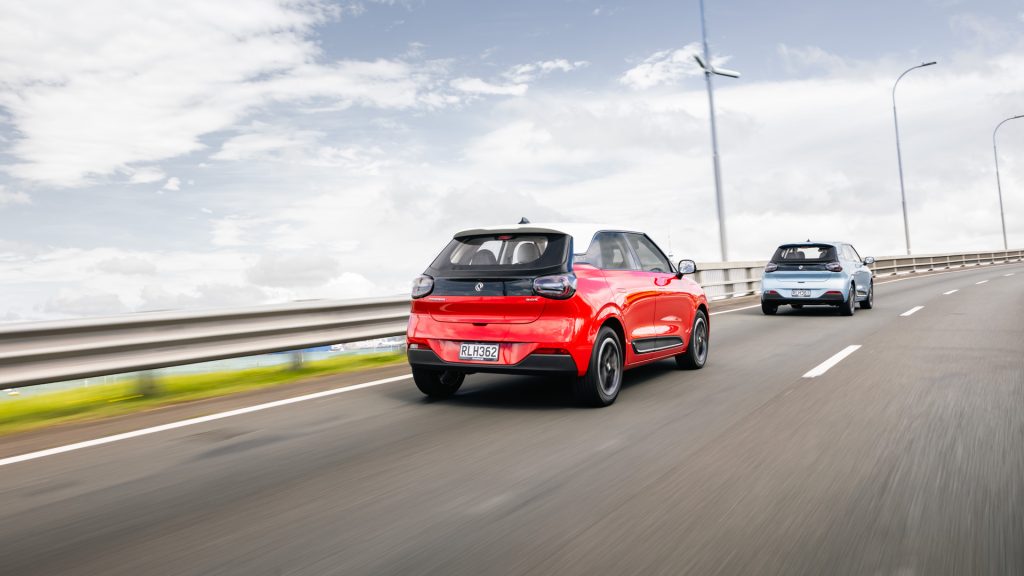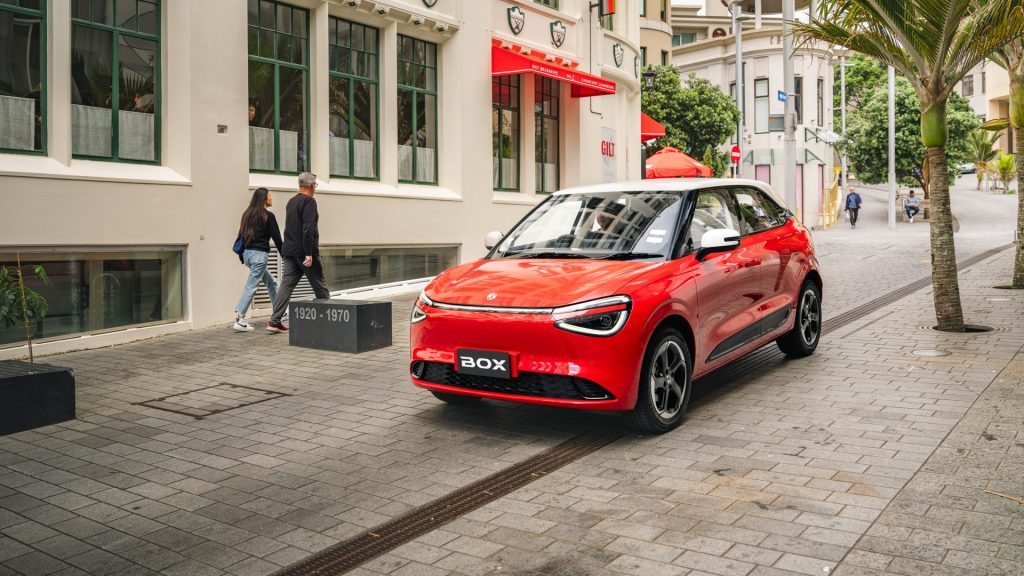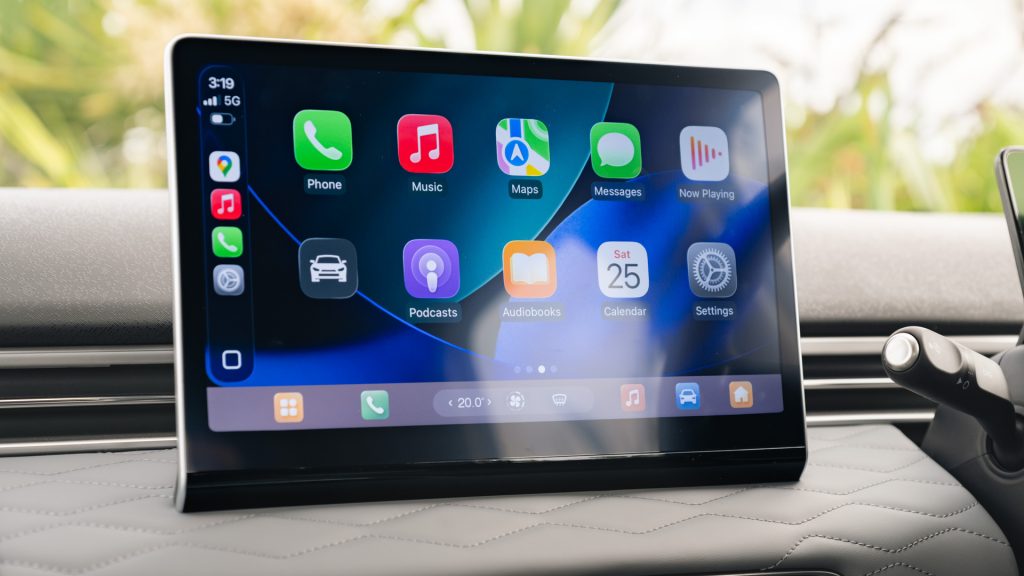First drive: Dongfeng Box signals a new chapter for affordable EVs
Words Richard Edwards | Images Supplied
You’d be forgiven for not knowing the name Dongfeng. In New Zealand, it’s brand new, but in China this state-owned carmaker is a motoring giant, building more than two million vehicles a year, from micro vans to luxury Voyah SUVs to driverless port trucks.
Now, through Armstrong’s Distribution, Dongfeng has officially arrived here, and it’s come armed with something the market hasn’t seen for a while: a genuinely affordable electric hatchback.
At $29,990 + ORC, the Dongfeng Box is the only new EV in the country under thirty grand, and perhaps more significantly, the only light electric hatch ready for immediate delivery.
City-sized, but not short on substance
At 4.02 metres long and just over 1.8 metres wide, the Box roughly matches a Mini Cooper in footprint. But a long 2663 mm wheelbase gives it an unexpectedly roomy cabin. The back seat is adult-usable, and the boot starts at 326 litres, expanding to 945 litres with the rear and even the 180-degree folding front seats laid flat.
Underneath sits Dongfeng’s ‘Quantum Architecture’, shared with the company’s upcoming 007 sedan, and a compact 10-in-1 “Mach Power” electric drive unit. Power is modest at 70 kW and 160 Nm to the front wheels, but in the real world it feels punchy enough. Dongfeng quotes 0–50 km/h in 4.6 seconds and a 140 km/h top speed. Around town that’s more than enough shove, and the instant throttle response is the usual EV delight.
The 43.9 kWh LFP battery sits beneath the floor, giving a 317 km WLTP range, and it is believable. We found city consumption around 12kWh per 100km and open road (hills plus 110km/h roads) of under 15kWh per 100km. Charging is handled via 6.6 kW AC or 60 kW DC fast-charging, the latter taking it from 30 to 80 percent in about 30 minutes.
Dongfeng has chosen air cooling rather than liquid, which will raise eyebrows among enthusiasts, but the system is designed for simplicity and longevity. We’ll be interested to test if it struggles with multiple fast charges in a day.

Character by design
Where some budget EVs go heavy on minimalism, the Box brings personality. Frameless doors, hidden handles, and a through-bar LED light strip give it an almost concept-car face. Two-tone paint options, including a punchy red-and-white combination, add some flair, while 17-inch alloys and a pert tail give it stance.
The cabin feels more boutique than bargain. There’s leatherette upholstery, soft-touch surfaces, and a 32-colour ambient lighting setup that would embarrass a few premium brands. The 12-inch central display runs Dongfeng’s own operating system with wireless CarPlay and Android Auto, while a 5-inch driver screen keeps essentials tidy.
The infotainment is functional but lacks depth or polish, which is fine. However, the Apple CarPlay implementation, delivered through a hidden aftermarket adaptor, is clumsy and failed on us during testing. The wireless phone charger includes active cooling to stop your phone overheating on long drives, but it struggled to pump much power into our iPhone 17.

The six-way power driver’s seat includes heating, ventilation, and memory, which is unheard of at this price point, and the seats are genuinely comfortable. The steering wheel lacks reach adjustment, but its positioning isn’t terrible.
Little touches include an optional frunk ($500 installed), a slide-out centre drawer, and an external speaker and avatar that greet you as you approach.
Light on weight, not on fun
Tipping the scales at 1345 kg, the Box is among the lighter EVs on the market, but the build quality feels rather good.
It’s surprisingly nimble and easy to place, with quick, accurate electric steering. Suspension tuning leans soft, aimed at comfort over corner carving, but body control remains tidy. It’s no hot hatch — you can’t escape the battery mass underneath — yet it drives with more polish than expected for something wearing a sub-$30k tag.

The driver assistance package is solid: Level 2 assistance, adaptive cruise with traffic-jam assist, lane-keep, AEB, collision warning, speed-sign recognition, and even automated parking aided by a 360-degree four-camera system. We weren’t expecting it all to live up to much, but to be honest it’s one of the best-sorted ADAS packages we’ve experienced straight out of the box (pun intended). The adaptive cruise control and lane centring needed virtually no intervention other than keeping hands on the wheel during lane changes from the Auckland Harbour Bridge to Warkworth. We’ve driven $200k vehicles that couldn’t do the same.
Even the control buttons are tactile. It’s simple, but it works.
Safety point
We can’t overlook the fact that the BOX received a three-star Euro NCAP safety rating. During the frontal offset crash test, designed to simulate a common car-to-car collision, multiple spot-welds failed on part of the BOX’s body shell. In other testing the driver’s airbag failed to deploy with enough force.
ADL management note that though that the car only missed a four-star rating by one point, and that the factory is aware of the failures and is working on them.
Ownership and outlook
The Box comes with a six-year/200,000 km vehicle warranty, eight-year/200,000 km battery warranty, and six years of roadside assistance. Servicing is every 15,000 km or one year.
Financing is handled through Dongfeng Finance, a new partnership with Heartland Bank, which will add Guaranteed Future Value (GFV) options in 2026.
Rutherford acknowledges that New Zealand’s EV market is cooling but sees that as an opportunity rather than a setback. “To grow the market, we have to make EVs genuinely accessible,” he says. “That means affordability, yes, but also usability and trust.”

The bigger picture
Two more models will arrive in early 2026: the Vigo, a small-to-mid-size SUV with a 51.9 kWh LFP battery, 120 kW motor, 340 km WLTP range, and 18-minute DC fast-charge window; and the sleek 007 sedan, Dongfeng’s flagship.
The 007 will come in two flavours: a 200 kW single-motor with 540 km range, and a 400 kW dual-motor AWD capable of 0–100 km/h in under four seconds, using a 73.5 kWh LFP pack.
Dongfeng, meaning “east wind”, is one of China’s “big four” automakers, operating for 55 years and holding more than 20,000 patents. The company builds everything from Nissan and Honda joint-venture models to luxury Voyah and off-road MHero vehicles.





